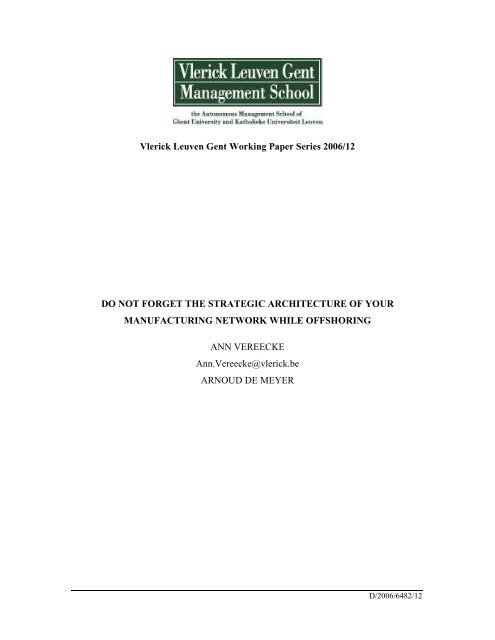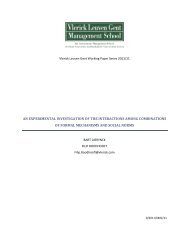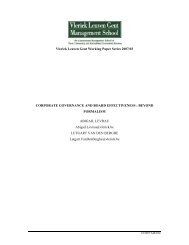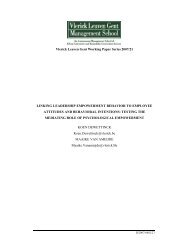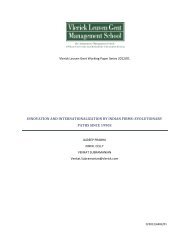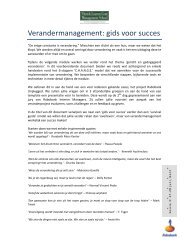Vlerick Leuven Gent Working Paper Series 2006/12 ... - Vlerick Public
Vlerick Leuven Gent Working Paper Series 2006/12 ... - Vlerick Public
Vlerick Leuven Gent Working Paper Series 2006/12 ... - Vlerick Public
Create successful ePaper yourself
Turn your PDF publications into a flip-book with our unique Google optimized e-Paper software.
DO NOT FORGET THE STRATEGIC ARCHITECTURE OF YOURMANUFACTURING NETWORK WHILE OFFSHORINGANN VEREECKE<strong>Vlerick</strong> <strong>Leuven</strong> <strong>Gent</strong> Management SchoolARNOUD DE MEYERInseadContact:Ann Vereecke<strong>Vlerick</strong> <strong>Leuven</strong> <strong>Gent</strong> Management SchoolTel: +32 09 210 98 55Fax: +32 09 210 97 00Email: Ann.Vereecke@vlerick.be2
ABSTRACTOffshoring manufacturing to low labor cost countries has become trendy. Nearlyeveryday one sees an announcement in the business press of companies moving to Chinaor India. Whilst production cost is an important consideration in choosing a location forthe factory, we argue that one should not become victim of a herd effect and that otherparameters e.g. quality, flexibility, transportation and energy costs, etc. need to be takeninto consideration in the determination of the optimal manufacturing network. Relocatinga factory is changing the strategic architecture of the company’s manufacturing networkand requires a long term view and a good model to design the architecture of themanufacturing network. Based on empirical survey research and a set of case studies weprovide such a model to think about the roles of factories in the strategic manufacturingnetwork of the firm. But we go beyond a classification and a descriptive model and weprovide a set of six managerial issues that require senior management’s attention indetermining the optimal manufacturing network and its dynamic evolution. We argue forexample that senior management needs to build a balanced portfolio of different types offactories, has to have a performance measurement system adapted to the type of factory,as well as the appropriate leadership for each of the different types of factories and needsto actively manage the dynamics and the flows of innovation in the factory network.Key words: international manufacturing, network management, outsourcing3
YOU NEED TO DEVELOP A STRATEGIC VIEW OF THE FACTORYNETWORKWhilst we acknowledge the importance of cost optimizations in themanufacturing network, we also strongly believe that the decision to relocate a factoryshould be taken within a broader perspective. Relocating a factory means the company ischanging its manufacturing network. This is a strategic decision, which will have animpact on the competitiveness of the company. The delocalization decision shouldtherefore be taken with this strategic network perspective in mind.The manufacturing strategy literature provides some models or frameworks thatsupport the manager in this decision. Hayes and Schmenner classify factories accordingto their focus, which can be the market, the product or a step in the process. Marketfocused factories will be more responsive to customer needs, while product or processfocused factories enable the company to benefit from specialization and to build on itscapabilities (Hayes and Schmenner, 1978). The choice between these three dimensions offocus will depend on the characteristics of the industry. For example, one would expectfood factories to be closer to the market, while chemical factories will rather be wherecapabilities can be easily exploited.Kasra Ferdows (1997) added a different perspective to the discussion. At the coreof his framework is the observation that each factory has a strategic role to fulfill: its rolemay for example be to serve a market, to act as a low-cost source of products orcomponents, or to take the lead in the development and transfer of innovations. Theconcept of the lead factory, which shares its innovations and knowledge with otherfactories, stresses the idea that multinational manufacturing companies are more than aset of factories. Rather, their manufacturing configuration is a network, and should bemanaged as such. The strength of an international company lies in its potential to buildand exploit a network of knowledge, which goes far beyond its potential to minimizecosts.In our own work we have extended this view. Traditionally a manufacturingnetwork is seen as a supply chain, with goods (components, semi-finished products orend products) flowing between the factories in the network. But it can also be describedas a network of knowledge, with innovations and information flowing between the6
factories. We actually argue, similar to Doz, Santos and Williamson, that the strength of amultinational manufacturing company lies precisely in its potential to exploit its networkof knowledge (Doz, Santos and Williamson 2001). Doz et al use this idea with respect tothe product and service innovations developed by the firm. We apply this networkconcept to process innovation and manufacturing. As a consequence we present a modelthat classifies factories according to their role in this network of knowledge.The argument we would like to put forward is that a relocation decision shouldtake into account the role the factory plays in the network of knowledge in the company.In moving the factory, we are changing the strategic architecture of the network. And thismay well completely upset or even destroy the medium to long term equilibrium in thenetwork in order to obtain short term gains. More specifically, we may be hurting theinnovation flows in the network. This would be really detrimental to the long termsuccess of the network and the company and the question how the network is adjustedshould be on the board’s mind in deciding about the future of a factory.ABOUT OUR RESEARCHOur proposals are based on in-depth case research in eight multinationalmanufacturing companies, with headquarters in Western Europe. The confectionaryproducer Callebaut, now part of the global Barry-Callebaut group, was one of the cases,with manufacturing facilities in Belgium, the UK, Canada and the USA. Anotherinteresting case has been Bekaert, producer of steel cord, which is a major supplier to thetire industry, with factories in Europe, Asia and the Americas. Also Samsonite Europe,producer of luggage, handbags, backpacks … was part of our study.We conducted interviews in these multinationals with executives inmanufacturing and supply chain functions in headquarters; questionnaires have been sentto the factory managers and their management teams in each of the factories in themultinational network. The conclusions drawn from this research have been discussedwith many managers from many different companies, in many different industries inexecutive programs and during consulting projects. Their reactions and comments havebeen structured and are integrated in this paper and render our results much more robust.7
Based on all these measurements we were able to distinguish four types orcategories of factories. The first category of factories consists of the “isolated” factoriesin the network. Few innovations reach this isolated factory and few innovations aretransferred from here to other units; few manufacturing staff people come to visit such afactory, and in reverse also few manufacturing staff people from this factory go visitother factories. Moreover, there is little communication between the manufacturing staffpeople of this factory and the other manufacturing managers in the network. The canproducer in our research showed quite a few isolated factories. These factories aretypically high performers, supplying commodity products to their local market, andrelying on their own capabilities to improve their manufacturing processes. Some of themare green field factories, which run in an efficient, reliable and independent way.Similar to the isolated factories are the “receiver factories”. They differ from theisolated factories on one aspect only: they receive quite a few innovations from otherfactories in the network and/or from headquarters. There can be a few different reasonsfor this ‘injection’ of innovations in the receiver factory. Some of these factories areunderperforming, and need external support to get the factory up to standard. Others arelocated so close to one of the sister factories, that they are run as ‘satellite factories’,under the supervision of the management team of the neighboring, typically larger,factory. Still other factories have to rely on external support to keep up to speed withrapidly changing technological innovation. A nice example in this respect is a state-ofthe-artsteel cord factory. This factory was the experimental unit in the network for theapplication of Computer-integrated Manufacturing. It was supposed to become the‘model factory’ for the future, with zero defects and zero interruptions. In order toaccomplish this, the factory received a lot of support from other factories and fromdevelopment teams in the company.The third category of factories is very different. This category consists of factoriesthat have established strong network relationships. These network players show a highlevel of communication with other units in the network and they exchange a lot ofinnovations with the other units. They not only transfer innovations to the other factories,they also benefit from innovations developed elsewhere. Typical for these factories is thatthey are frequently hosting visitors from other factories in the network and from9
headquarters. This is why we have labeled them the ‘hosting network players’. Quite afew of the hosting network players in our research were the factory closest toheadquarters. They thus had automatically a central position in the network. Someinterviewees referred to this factory as the ‘mother factory’. An example of a hostingnetwork player was the steel cord factory located about 50 km from the Bekaertheadquarters. This factory was very flexible, and produced a large range of products, fora broad geographical market; its location close to the technical development center inheadquarters turned this factory into a prototype testing center; engineers from all overthe world would go through training in this factory; finally, the factory was considered tobe a center of excellence for part of the product range of the company.The main difference between the hosting network players and our fourth category,the ‘active network players’, lies in the intensity of communication and of innovationtransfers, and the dominant direction of the flows of visitors. These are factories thatcommunicate intensively with other units in the network; they share very activelyinnovations with other units; and they are not only hosting visitors from other factories,they also pay lots of visits to the other factories.An interesting example of an active network player was a small Samsonite factoryin Belgium, close to the product design center in the European headquarters. This factorywas a pilot center for new designs of luggage. It compensated for its high labor cost byexcelling in the production of small runs of new products, with short delivery times.When the new product matured, it was then transferred to low-cost factories in EasternEurope.10
But let’s face it, network players are expensive factories. Their role as developersof knowledge implies a need for investments and resources. Being networkers probablyeven implies some inefficiency. Their managers spend a lot of time traveling, the visitorsin their factories “disturb” the normal operations in the factory, training takes time,networking also means time in meetings and other forums where information is shared.As a consequence, these factories should be allowed some slack capacity to be able tofulfill their role of hosts and network players. It wouldn’t be wise to allow for theseinefficiencies in all factories.Therefore, the network players should be complemented with some isolatedfactories, which are run in a very lean, efficient and low cost way, as such safeguardingthe overall cost of the manufacturing network. Moreover, isolated factories offer strategicflexibility to the network. In case of a geographical expansion into new markets, theseisolated factories can be used as the bricks in building the international manufacturingnetwork. Copying the concept of a factory and replicating it in distant markets providesan easy and rapid way to start serving these distant markets and maybe even to startsensing trends in these markets, which may then stimulate the development ofinnovations in the network players. This idea of “copy/paste factories” is especiallytypical for companies with low value density products. A can producer, for example, will“copy/paste” similar factories all over its geographical market.Also, relocating isolated factories is relatively easy; it implies a relocation ofcapacity. The shift in production in the textile industry illustrates this point. Over a periodof roughly ten to fifteen years, textile producers have shifted production from NorthAfrica or Mexico, over Mauritius, to Bangladesh, and finally China. “Picking up” themachinery and moving it to another country seems to be a relatively easy job.Relocating network players is much more difficult. Their capability to serve asdevelopers of knowledge may well be rooted in their location close to sources ofknowledge or close to some specific expertise. For example, they may have a tight link tothe R&D center of the company, or they may be located in a region with a long traditionof the company’s industrial activity. When Tupperware decided to build new facilities forits Belgian production, it could have decided to build the green field factory in a lowlabor cost country. However, management decided to build the new factory only a couple<strong>12</strong>
of kilometers away from the old facilities. The reason? The know-how of its workforce,the nearness of R&D which allows for interaction between design and manufacturing andfor experimentation on the shop floor. Another example are automotive producers e.g.Daimler Chrysler. This company will probably always have some manufacturingfacilities in the “golden triangle” for automotive design and production between Stuttgart,Mulhouse and Torino, because of the blend of knowledge available in this area, throughsophisticated suppliers, universities specializing in research on the automotive industry,machine construction, and design labs. Yet at some point in time, automotive companiesmay want to understand trends in Japanese car factories, which may give them a need foractive network players, to tap into this knowledge. The Japanese Nissan factories in theRenault network may well have taken on the role of an active network player that bringsNissan’s knowledge in process engineering into the Renault network. Daimler Chryslertried to do the same with Mitsubishi Motor Company, but failed to take advantage of thisventure.Ultimately, one may even consider outsourcing the activity carried out in theisolated factory. In doing so, the total cost may be reduced, provided the activity is takenover by a partner who has specialized in it. Yet it doesn’t harm the innovation power ofthe network, since the factory isn’t sharing any important knowledge with the otherplayers in the network.The same argument goes in favor of receiver factories. We need them in thenetwork, for the same reasons as the isolated factories. For processes where technology israpidly evolving, one probably needs receiver factories rather than isolated ones, whichare usually better suited for standardized production. The concept of the receiver factoryis to be used if the factory has to keep up to speed with the latest technologies.Do type of factory and geography go together?Is there some geographical preference for each of the types of factories? Would itbe the case that isolated and receiver factories are typically located in low-labor costcountries? And that network players are by definition to be found in industrialized13
countries? This, we are convinced, doesn’t always reflect reality. Especially activenetwork players could – and probably should - be located all over the world. The mainquestion here is where interesting sources of knowledge are to be found. Tapping into asource of knowledge, and transferring this knowledge across the network, is the primarytask of an active network player.The story is different for isolated or receiver factories. Although in theory thesefactories can be located anywhere, presence in high wage countries is probably notsustainable. Imagine an isolated factory in an expensive country, in terms of labor cost,such as Japan, Switzerland or Belgium. This factory has a competitive disadvantage visà-visthe other factories in the company’s network. If the company runs intoovercapacity, the decision to reduce capacity may easily turn into a downsizing or evenclosure of this factory. In doing so, the company is simply “cutting out” capacity, withouthurting any of its flows of innovation. The story would have been different if this factorywere a network player. In this case, cutting capacity would also have meant cutting vitalinnovation flows, and therefore hurting the innovative capability and the competitivenessof the network.One of the Belgian factories in our study is a clear example. This factory acted asa receiver: expertise from other factories in the network and from headquarters wastransferred to this factory in order to improve its performance. In reverse, however, thefactory had no innovations or best practices that it could share with the other factories. Ina period of downsizing, this factory was the first “victim” and was closed.Consequently, there is likely to be some self-selection among isolated andreceiver factories in high wage countries. They either struggle for survival, or movetowards lower wage countries.14
Don’t compare apples with oranges: different types of factories needs to beevaluated on different criteriaThe previous discussion leads to the issue of performance measurement in themanufacturing network. If the decision on reduction or expansion of factories is to bemade with the network role of the factories in mind, it implies that management needs aperformance measurement system that takes these network roles into account.We have argued earlier that a typical isolated factory is a lean factory, establishedto serve its local market efficiently, often as a copy of one of its sister factories. It is clearthat such a factory should be evaluated in terms of its cost and efficiency, as well as itsmarket orientation. The latter can be measured through its delivery speed and reliabilityand the degree of service it gives to its market. Obviously, these measures are alsoimportant for the receiver factories. However, a receiver factory also has to absorb theinnovations that come from other units in the network, and has to improve itsperformance through the adoption of these innovations. Therefore, it is more important tomeasure the rate of performance improvement than the absolute level of performance ofthis factory. Rather than evaluating the factory, for example, on its cost level, one shouldbe evaluating it on its speed of cost reduction and of increase in productivity. To use theBalanced Score Card terminology, the performance evaluation of the factory should focusheavily on the learning capabilities in the factory. Does this factory implement theinnovations it receives? Is this factory building competencies? Does it have theabsorptive capacity needed to capture innovations and implement them successfully?The story is again different for network players. While cost, delivery and servicecan not be ignored here, the focus should be on the evaluation of the networking role ofthese factories. In order for these factories to add value to the network, they must remaina strong source of innovation. Consequently, measures of innovativeness are crucialbenchmark elements. The number of new product introductions introduced in thesefactories, the number of successful process changes implemented in these factories, thenumber of improvement suggestions generated by the work force, may be interestingmeasures of performance in network players.15
Hosting network players may require yet another measure of performance. Fromthe earlier discussion, we remember that active network players are sort of “the new kidon the block”. This is very different from the typical hosting network player, which hasbeen in the network for quite a long time, and is somewhat the “home place” for themanagers in the distant factories. The role of the hosting network player is to preserve theheritage, to be the beating heart where the values and the mission of the company aremaintained, to be the node in the network where the corporate culture is very muchpresent and is passed on to others. While it is very difficult to measure and evaluate towhat extent the factory really fulfills this role, some proxies can be defined asperformance measures. An example may be the number of days of training delivered inthis factory for managers coming from other factories in the network, or the number ofcolleagues that have visited this factory over the past year. Or the number of monthsmanagers of this factory have spent in other factories in the network.Tune the behavior of your factory managementIt is important to note here that in a benchmarking exercise one has to find thedelicate balance between competitive and cooperative behavior in the factories. Networkplayers should be motivated to share their innovations with other factories in the network.It is therefore risky to benchmark these factories in terms of their absolute performanceon cost and productivity against isolated or receiving factories, since this might convincethem that they’d better keep their performance improvements for themselves. Such aprotective attitude would not only kill their crucial role of network player. It would alsodry out the flow of innovative ideas they receive from their sister factories. Indeed, as onecan see in Figure 1, the factory that shares innovations is also the one that receivesinnovations. As such, if the network player stops to share innovations, it will sooner orlater also experience a reduced inflow of innovations; this in turn will weaken theinnovativeness of this factory, which will in the long term undermine its capability toremain a network player. Stated differently, benchmarking is a useful tool in motivatingfactory management, and as such is making the network stronger. But it should be usedwith great care, in order to avoid a counter-productive effect.16
implemented by Samsung had the improvement of relations between groups of workersas a consequence. This system consisted of one Korean taking care of 3 German workersfor an in-depth visit of the Korean factory during 6 days.Another intriguing observation has been that, although effective networks have aconstant flow of technological knowledge, this flow was not steady and continuous. Infact we saw that knowledge was transferred in big bursts, alternated with periods ofconstant but relatively low flows of knowledge.AND WHAT ABOUT THE FACTORY MANAGER: HOW CAN SHE DEFENDHER FACTORY?Our research findings also include a warning signal for the factory manager,especially in those factories located in high labor cost countries. Such factories are at acost disadvantage, compared to their sister factories in the network, unless they cancompensate for the high cost of labor by reaching high productivity levels. For managersin network players, the tendency may exist not to share knowledge with others, so as tokeep the productivity improvements to the factory. Such a protective attitude will notonly hinder the network to improve its overall performance, it will also bring the factoryin an isolated position. As we have just shown, this will constrain the flows of knowledgethe factory may expect to receive in the future, and as such may in the long term reducethe innovative power of the factory. But even worse, it will change the role the factoryplays in the network. If sooner or later the company needs to reduce capacity, this factorywill be an easy victim. By downsizing this factory, the company will have accomplishedits objective to reduce capacity, without hurting the knowledge flows in the network. Atthe end of the trip, an attempt to protect the factory may well have turned into a scenarioof making the factory abundant.Managers in isolated or receiving factories should realize that the role of theirfactory is merely to provide capacity to the network. If, as argued above, capacity in thenetwork needs to be reduced because of a declining market, or if cost reductions can beobtained by relocating the factories, these factories may well be on the shortlist forclosure. In industries with low value density, where proximity to the market is an20
important issue, this is not likely to take place. However, if transportation distance is nota major criterion for factory location, the future of the factory may be at stake. From theperspective of headquarters, this is exactly the strategic flexibility that has purposely beenbuilt into the network. From the perspective of the factory management, this is hard toswallow, since it involves lay-offs and therefore has an impact on the life of theemployees and their families, as well as, in the long term, on the welfare in a region.This brings us back to the discussion on delocalization. While strategicallyimportant to safeguard and improve the competitiveness of the multinational, it is oftenperceived as unavoidable and yet unfair at the level of the factory. It is our belief thatindeed it is unavoidable for some of the isolated and receiving factories in high labor costcountries. Consequently, these factories may protect themselves, not by complainingwhen it is too late, but rather by anticipating through building network relationships. Thistakes time, it requires careful strategic planning, and the willingness of headquarters toinvest in these network relationships. Network players on the other hand shouldunderstand the importance of their role in the network, and should keep on investing intheir own innovation capability, as well as in the transfer of their knowledge to the otherplayers in the network. While sharing their knowledge may seem too generous in theshort term, it is precisely their reason for existence, and their guarantee for survival in thelong term.CONCLUSIONSSo what’s our advice to the senior management in multinational manufacturingcompanies? Let’s summarize it in a few short messages:• Do not follow the herds in the short term. You may need to relocate factoriesto low cost production countries and we all may have to go to China or India.But look beyond the cost of the manufacturing network: develop a trulystrategic view of the factory network. And remember: a network is more thanthe nodes, it is also about the flows and the ties these nodes have developedwith the local environment.21
• The network benefits from diversity; search for a good balance in the rolesplayed by the factories in the network. Keep in mind in which environmentthe multinational operates. Different environments require different sets ofroles for the factories.• Different roles require different performance measures. Use benchmarkingwith great care.• Knowledge networks require attention, commitment and resources. Inparticular, personal relationships should be nurtured for knowledge transfersto take place.• The role of a factory in a network should be dynamic. But the control over these dynamics should not be left to the hands of the factory managers only.Then you would have only an evolution of the individual nodes. There is aneed for a coordinated evolution of the network, i.e. of both its nodes and itsflows22
REFERENCESBARTLETT, C.A., and S. GHOSHAL (1989), Managing across Borders: theTransnational Solution, Hutchinson Business BooksDE MEYER, A., and B. PYCKE (1997), Samsung Berlin, INSEAD case no. 0297-4672DE MEYER, A., and J. PROBERT (1998), Francolor Pigments : a Toyo Ink Acquisition,INSEAD case 0598-4756DE MEYER, A., and J. PROBERT (1997), TWL: Pondicherry Plant, INSEAD case no.0797-4711DE MEYER, A., and J.I. CHOI, Daewoo FSO plant, unpublished manuscriptFERDOWS, K., (1997), “Making the Most of Foreign Factories” Harvard BusinessReview, Jan-FebHAYES, R.H., and R.W. SCHMENNER (1978), “How should you OrganiseManufacturing ?” Harvard Business Review, Jan-Feb, 105-118VEREECKE, A., R. VAN DIERDONCK and A. DE MEYER, “A typology of plants inglobal manufacturing networks”, Management Science (forthcoming)Doz, Y., J. Santos and P. Williamson (2001). From Global to Metanational. Boston,Massachusetts, Harvard Business School Press.23
FIGURE 1Network role of the factoryinnovationsisolated factoryreceiver factoryinnovationsmfg staffhosting network playerinnovationsactive network playermfg staff24


